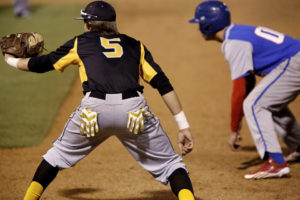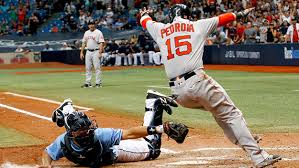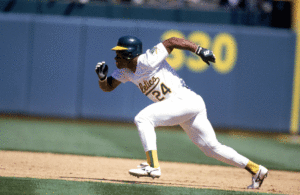Basics
The key to understanding baserunning is to remember the rule about the clock in baseball: namely, that there isn’t one! Except for when a ball leaves the field of play (for example, into the grandstands in foul territory), or the brief intervals of time-out when a player or umpire so desires, there is no official break in the game. What this implies is that baserunners are fair game to be tagged out at any time that they are not safely on a base. So they have to be on their toes! It also means that they can run to the next base (assuming it is unoccupied) at any time, so the defenders (mostly the infielders and the pitcher, here) need to be on their toes as well.
 Runner and fielder giving full attention to the pitcher, who has the ball.
Runner and fielder giving full attention to the pitcher, who has the ball.
Of course, there are practical considerations here: a ball can be thrown much faster than a player can run, so there are only very brief moments when a player may take the risk to run to the next base. Of course, if a player is forced to the next base, he needs to run, whether it is safe to or not. (Exception: if a player is forced to the next base by a walk or hit batsman, he is not subject to being tagged out on his way there, in fact he can saunter if so desired). 1
Example: runner at second. Batter hits a line drive to the outfield that is not caught in the air. Will he run to third base? Usually, yes, because he will have started partway to third anyway. Will he score? Depends on which part of the outfield, who is the fielder, how strong is the fielder’s arm known to be, etc etc. These decisions need to be made on-the-fly, with assistance from, in this case, the third-base coach.
A semantic diversion
The word “lead” (leed, not led) has three meanings in baseball; the word “tag” has two. “Lead” can mean: to be ahead in the score (“The Sox lead the Yankees by two runs after three”); the runner that is furthest advanced toward home plate (“Bogaerts throws to third to cut down the lead runner”); the first batter in a game or inning (“Leading off for the Sox is Mookie Betts”); oops make that four meanings! The most important one for our baserunning purposes: the distance that a baserunner moves toward the next base while awaiting the next pitch. This will be the subject of the next paragraph. But first, “tag”: to touch an offense player with the ball (or more commonly, with the glove containing the ball); to run to the next base after a fly ball has been caught (sometimes called “tagging up”). More on this one later.
 Dustin Pedroia, avoiding a tag at home plate.
Dustin Pedroia, avoiding a tag at home plate.
The lead
Runner at first, pitcher has the ball. The runner will take a few steps toward second base, watching the pitcher closely. Being closer to second makes it more likely he will be able to get there if there is a hit; it also may be his preamble to a steal attempt (which we will get to in a minute). How big a lead will he take? As big as possible, as long as he stays close enough to dive back to the base if the pitcher whirls and throws the ball to the first baseman! You will see the first baseman waiting at the base, glove hand extended toward the pitcher, waiting for this very thing. 2 Note also, the runner is not technically forced to dive back to the base, although he would be crazy not to, so the first baseman needs to tag the runner, not just the base. If the runner is tagged out in this situation, it is called a “pickoff”, and is a real morale-buster for the offense.
When the pitcher starts the actual pitch, the runner will take a further step toward second; this is the “secondary lead”. Again, needs to stay close enough to be able to avoid being picked off, although in this case it is the catcher who would throw down to first and pick him off.
How can a runner tell if a pitcher has actually started a pitch? This is a subtle rule, but quite clear, and will be covered in the “pitching” section. Suffice it to say, for now, that there is a “point of no return” for the pitcher, after which he must pitch to the batter, and the baserunner can tell when that point has been reached, at which point he can take his secondary lead, or….
The Stolen Base
…can steal the next base! (Remember, of course, that a runner may not advance to an occupied base!!!). I mentioned that a runner is free any time to run to the next base, given he has time to do so safely before the defense can get the ball to someone that can tag him out. How much time is “enough time”? Well, the time it takes for a pitch to get to home plate, and for the catcher to stand and throw the ball to second, is enough time, for fast runners, about 65% of the time. The other 35% of the time, the shortstop, who will be receiving the throw from the catcher, will have time to tag him out. Of course, some players are more successful at base-stealing, due to quick acceleration, speed, and reckless disregard for their own safety. Other players, the slower runners, seldom or never make the attempt. The skill of the catcher is an important factor as well.
 Rickey Henderson, the greatest base-stealer ever.
Rickey Henderson, the greatest base-stealer ever.
It is, of course, impossible to steal first base; it must be earned in the conventional fashion. 3 It is possible to steal any of the other bases. Second is the most commonly stolen base, for several reasons: it is a longer throw for the catcher (127 feet vs 90 feet to third base); it puts the runner into “scoring position”; and it eliminates the most common form of double play. (More on that under defense). Third base is frequently stolen as well, but is a bit more difficult.
But wait, you may be thinking: How can a runner steal home plate? How can you steal when the pitch is going to the same place you are? Where is the time interval you need? One way is on the “front end of a double steal”: runners at first and third, runner at first attempts to steal second, and when the catcher throws down to second, the runner at third then steals home. Much more rare, but occasionally done, and one of the most exciting plays you will ever see, is the “straight steal of home”. A lot of factors need to align for this to be successful: a very fast runner, a methodical and predictable pitcher (ideally a lefty, so he is facing away), and a lefty batter (so he will see the runner coming and get out of the way, and so the defense will be naturally shifted to the right a bit, allowing the runner to take a bigger lead). Watch Jacoby Ellsbury of the Red Sox steal home against the Yankees!
The Fly Ball
A few separate rules apply to fly balls that are caught before hitting the ground. Foremost: all baserunners need to contact their base (ie the base they are on when the ball is hit) after the ball is caught. In fact, they are forced to! What does this mean? Runner at second base, fly ball to the outfield. Runner thinks the ball will not be caught in the air, so he runs toward third base. Outfielder makes a great catch. Runner is now in deep doo-doo, because he is required to get back to second base, and because it is a force situation, the second baseman only has to tag the base, after getting the throw from the outfielder, and the runner is out. This is one kind of double play, and that outfielder will be credited with an outfield assist.
But imagine another scenario. Runner at third base, fly ball deep in the outfield. Runner expects the ball to be caught, so he waits at third base, in contact with it, in a sprinter’s stance…the instant the ball is caught, he has fulfilled his obligation to be at the base after the catch, and he can now run home! This is known as tagging up, or simply tagging. You will mostly see runners tagging to run home, for two reasons: it scores a run, and because the plate is a long throw for the outfielder, who will throw home to try to beat the runner there with the ball. Whether he succeeds will depend mostly upon how deep into the outfield the ball was hit.
If there is a runner at third, and less than two outs, a batter will try to hit a fly ball to the outfield, using a more controlled swing than if he was trying for a home run, knowing the ball will be caught, but giving up an out to score a run on the tag-up. This is called a sacrifice fly, and does not count against the batter’s batting average.
(The other type of sacrifice is the sacrifice bunt, which we will cover in the section on fielding.)
One more thing: not every foul ball goes into the stands! There is foul territory that is still on the field, behind the catcher, along the baselines, and in parts of the outfield. A runner may tag-up on a caught foul ball!
 Bryce Harper doing a headfirst slide. Looks like a close play!
Bryce Harper doing a headfirst slide. Looks like a close play!
Runner going…
When the announcer says this, it means one of three things. It means that a runner is making a steal attempt, or a runner is assuming that his batting teammate will at least make contact with the ball (a hit-and-run, or, if runner is starting on third base, a squeeze). The third thing is this: two outs, runners on base in forced positions (ie without empty bases behind them), and three balls and two strikes (a full count). In this situation, the runners will run with the pitch. Why? If it is a ball, they can slow to a walk and continue to the next base. If it is a strike, the inning is over. If it is a fly ball or grounder, then a conventional out will likely be made, and the inning is again over. If it is an out-of-play foul ball, they walk back to their bases during the time-out. So there is no reason not to run!
Scoring a run on a ground-out
If, for example, there is a runner on third, and the batter hits a ground ball, and the infielder throws to first base to get the batter out, the runner can score. BUT there is a caveat here, and a very sensible one. If this results in the third out, the runner does not score a run, even if he gets to the plate before the batter is thrown out. This is to prevent the umpires from having to watch two areas, ninety feet apart, and having to determine which of two events occurred before the other.
Starting with the next post, we will switch over to defense, which for me is the most exciting part of a ballgame. Go get a hotdog and a beer, we’ll be right back!
- For example, if a runner is on first, and the batter walks, he moves to second base without risk. If, however, he is at second base, and nobody is on first, and the batter walks, he does not get a free pass to third!
- Since the first baseman is playing right at the bag, rather than in his usual position partway toward second base, this leaves a large “hole” in the defense between the first and second basemen.
- Recap: a base hit, walk, hit batsman, error, fielder’s choice, dropped third strike, and catcher interference: seven ways in all.
